Ever wondered how Valentine’s Day became so big? It’s a day filled with love, celebrated by many. Its history is fascinating, tracing back to ancient times. It has changed a lot over the years.
Every February 14th, people around the world show love and affection. This day has evolved from a religious event to a global celebration of love. Let’s dive into its captivating history.
Key Takeaways
- Valentine’s Day began as a feast day for Saint Valentine in 500 AD.
- It evolved into a romantic celebration in the 14th to 15th centuries.
- Geoffrey Chaucer significantly popularized the connection between Valentine’s Day and romantic love.
- The mass production of Valentine’s Day cards started in the 19th century, influencing its commercialization.
- Modern expressions of love now include virtual greetings and social media posts.
- Approximately 145 million Valentine’s Day cards are exchanged each year in the U.S.
- In 2023, U.S. consumers were estimated to spend nearly $26 billion on Valentine’s Day gifts.
The Ancient Origins of Valentine’s Day
Valentine’s Day has deep roots in history. Its valentine’s day origin goes back to ancient Rome and the Lupercalia festival. This festival in mid-February honored Faunus, the god of agriculture, and aimed to boost fertility.
The festival was lively, with valentine’s day events in history that shaped future traditions. Priests would run through streets, performing rituals. They used goat hide strips to strike women, believing it would bring fertility for the year ahead.
Over time, Lupercalia’s traditions merged with valentine’s day history. Pope Gelasius I banned Lupercalia in the late 5th century. Yet, the spirit of the festival lived on in a more romantic way.
St. Valentine, who secretly married couples against Emperor Claudius II’s ban, became a symbol of love and sacrifice. His death on February 14 made this day even more special in history.
In the Middle Ages, Valentine’s Day started to be seen as a day of love. This change was greatly influenced by poet Geoffrey Chaucer. His work linked St. Valentine with romantic love, turning the day into what we celebrate today.
Celebrating Lupercalia: The Roman Fertility Festival
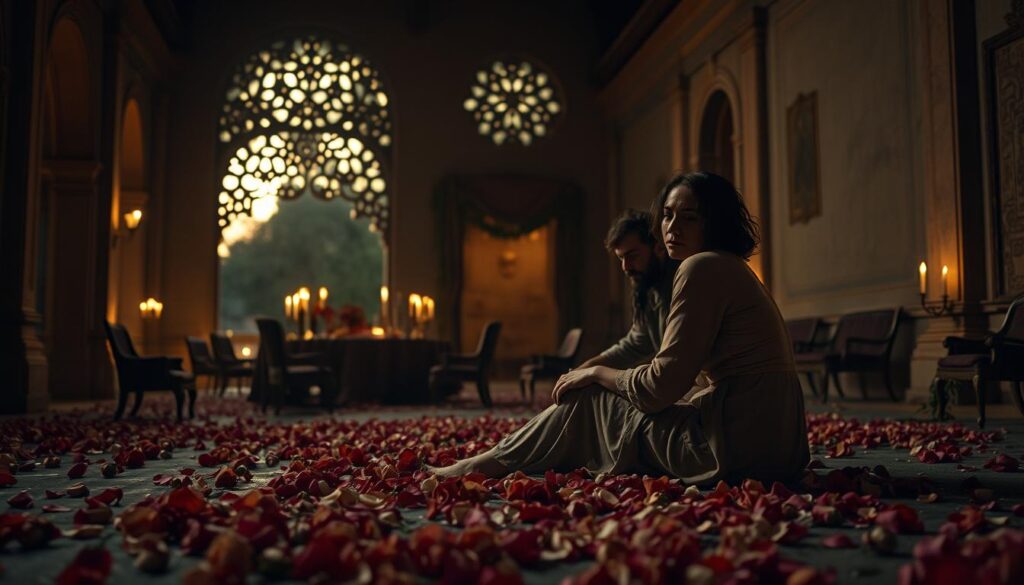
Lupercalia was a festival in ancient Rome, lasting from February 13 to 15. It was known for its lively and unique celebrations. Priests called the Luperci led rituals, including the sacrifice of goats and dogs.
These ceremonies were not just for show. They aimed to boost fertility. Women believed being hit with blood-soaked animal skin could help them conceive. This shows how men and women interacted in ancient times.
The festival also had a lottery system. Young women were paired with bachelors through a lottery. This was a different way of showing love back then. It’s interesting to see how these traditions might have influenced modern Valentine’s Day.
Looking at how love celebrations have changed over time is fascinating. From fertility rites to today’s Valentine’s Day, love has evolved. It’s clear that our views on love have changed a lot.
| Aspect | Lupercalia | Modern Valentine’s Day |
|---|---|---|
| Celebration Dates | February 13-15 | February 14 |
| Primary Activities | Rituals, fertility rites, temporary partnerships | Gifting cards, flowers, and chocolates |
| Involvement | Community participation, primarily among the youth | Widespread cultural participation across all ages |
| Symbols of Love | Strikes with animal skins | Hearts, Cupid, and flowers |
| Primary Emphasis | Fertility and matchmaking | Romantic love and consumerism |
The Life and Legend of St. Valentine
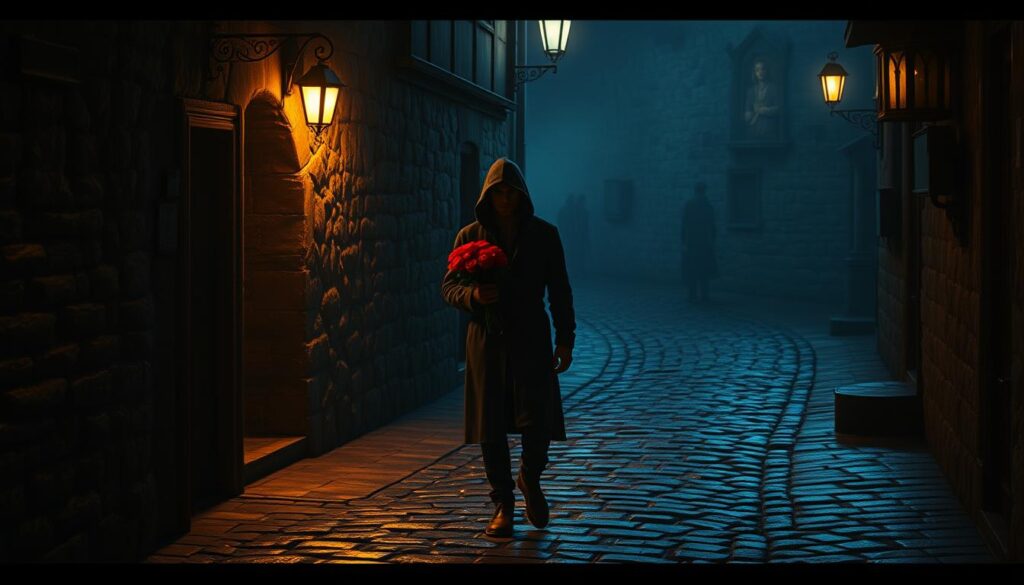
The story of Valentine’s Day is deeply connected to St. Valentine. He was a priest in third-century Rome. Emperor Claudius II wanted young men to be soldiers, so he banned marriage for them.
St. Valentine ignored this rule and married couples in secret. He was arrested for this. While in jail, he healed the jailer’s blind daughter. He signed a note to her, saying “from your Valentine.” This act made him a symbol of love.
St. Valentine was killed around A.D. 270. This made him a martyr. Later, Pope Gelasius made St. Valentine’s Day in the 5th century. It replaced a pagan festival, Lupercalia, on February 15.
In the Middle Ages, Valentine was loved in England and France. People believed February 14 was when birds started mating. This made him a symbol of love and courage.
Happy Valentine’s Day! Valentine’s Day has a rich and interesting history
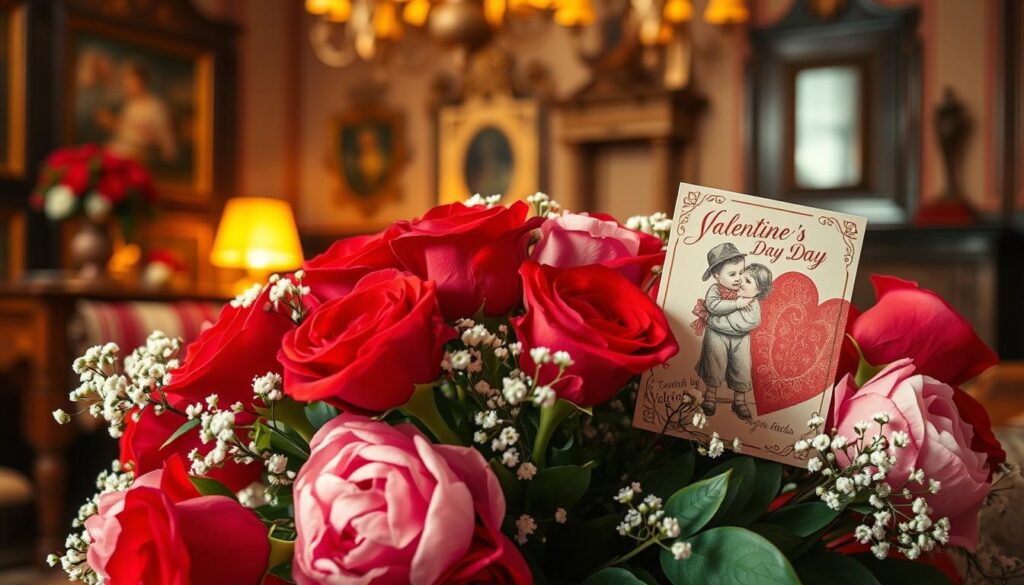
As you celebrate Valentine’s Day, it’s key to know its fascinating history. This day has evolved from ancient fertility rituals to a celebration of love. It started with the Roman festival Lupercalia, honoring love and fertility.
The history of Valentine’s Day shows its link to romantic expressions since the 14th century. Geoffrey Chaucer’s poems helped connect the day with love. Today, Valentine’s Day is filled with gifts, flowers, and celebrations.
Every year, 145 million Valentine’s Day cards are sent in the U.S., making it a big day for cards. About 73% of people celebrate by buying flowers. In 2023, people are expected to spend $21.8 billion on Valentine’s Day, showing how much we value it.
Valentine’s Day is a time for love and connection. It combines old traditions with new ones. So, you can fully enjoy this day, knowing the history of love that brought you here. Happy Valentine’s Day!
Geoffrey Chaucer’s Influence on Valentine’s Day
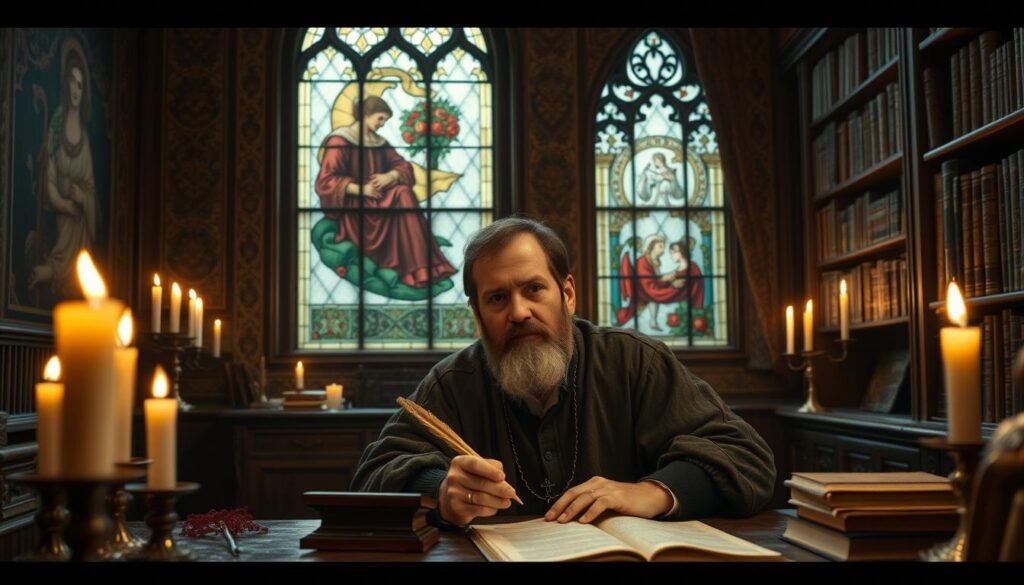
Valentine’s Day has changed over time, thanks to cultural and literary events. Geoffrey Chaucer played a key role in making this day special. In his poem “Parliament of Fowls,” written around 1382, he linked February 14 to birds mating. This idea has shaped how we see Valentine’s Day today.
Chaucer’s poetry made love a central theme of this holiday. His work helped make Valentine’s Day a day for love. Other writers followed his lead, adding to the holiday’s romantic vibe.
Chaucer’s words, like “Love, on this day, is for all to admire,” set a new standard. This idea of love on February 14 has become a tradition. Today, Valentine’s Day is all about celebrating love, thanks to Chaucer’s influence.
The Evolution of Valentine’s Day Traditions
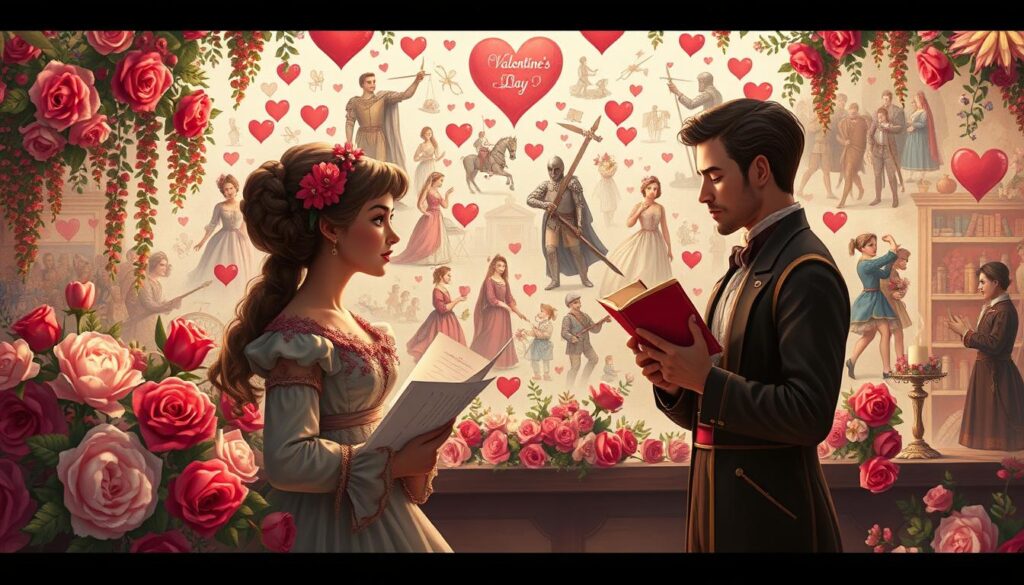
The history of Valentine’s Day is filled with interesting changes over time. It started with the pagan festival Lupercalia around February 15. Then, Pope Gelasius made Valentine’s Day on February 14 in the 5th century. This linked the day to the start of bird mating, adding to its romantic meaning.
Charles d’Orléans sent the first Valentine’s card in 1415 while in prison in England. In the 19th century, printed cards became popular, making it easier to show love.
In the late 19th century, Valentine’s Day became more commercial, especially in the United States. Gifts like chocolates and flowers became common. The Victorian era made roses a symbol of love. Richard Cadbury’s heart-shaped chocolate box made chocolate a key part of celebrations.
Today, Valentine’s Day is a mix of personal and commercial traditions. In Japan, women give chocolates on Valentine’s Day, and men return gifts on White Day. Romantic dinners, a tradition since the Middle Ages, now include special meals at home or in restaurants.
The idea of Galentine’s Day in 2010 celebrated friendships. In the Philippines, free weddings on Valentine’s Day show love and community.
In summary, Valentine’s Day has evolved with society, showing many ways to express love. From heartfelt letters to grand gifts, the day reflects changing views on romance through the ages.
The Rise of Written Valentines
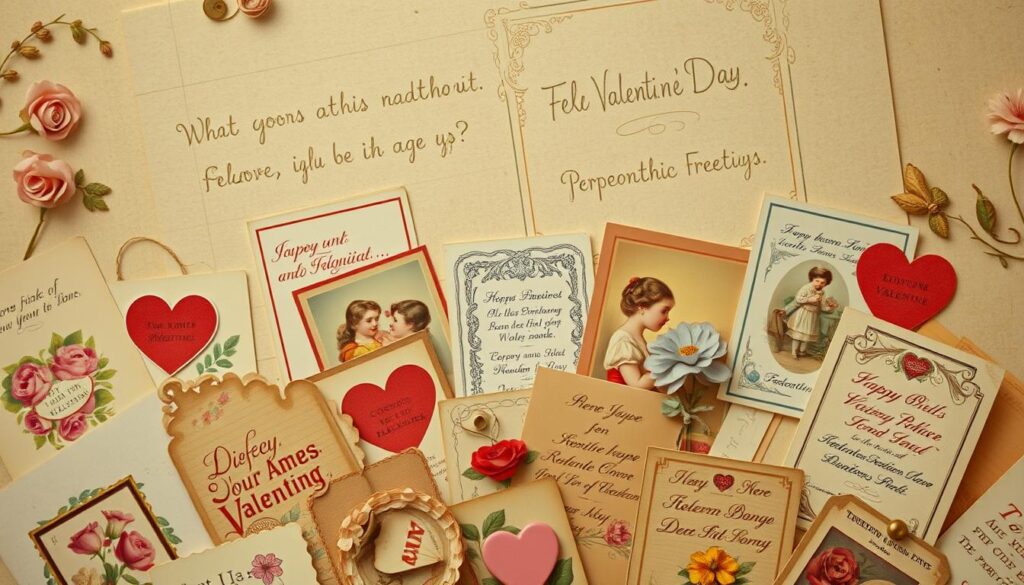
The history of written valentines is a key part of Valentine’s Day. It changed how we show love. Handwritten notes let people share feelings in a special way, making memories that last.
The Role of Handwritten Love Notes
In 1415, Charles, Duke of Orleans, wrote the first romantic Valentine. This started a tradition of love notes. The first English Valentine was written by Margery Brews in 1477.
These early valentines show how words can connect us. Handwritten notes became key for romance. They led to the beautiful cards we see today.
Esther Howland: The Mother of the American Valentine
In the 19th century, Esther Howland changed Valentine’s Day cards in America. She is known as the “Mother of the American Valentine.” Her designs won hearts everywhere.
Howland’s work showed the beauty of Valentine’s Day cards. Her efforts made the holiday even more special. She helped make love and cards a big part of our celebrations.
| Year | Event | Description |
|---|---|---|
| 496 AD | Pope Gelasius I’s Declaration | Established February 14th as the first Feast Day of St. Valentine. |
| 1382 | Chaucer’s Poem | Highlighted Valentine’s Day as a romantic occasion. |
| 1415 | Charles, Duke of Orleans’ Valentine | Earliest surviving romantic Valentine missive. |
| 1797 | Oldest Printed Valentine | Featured floral patterns and romantic verse. |
| 1840 | Penny Black Stamp Introduction | Marked a surge in Valentine’s Day card sending. |
Hallmark and the Commercialization of Valentine’s Day
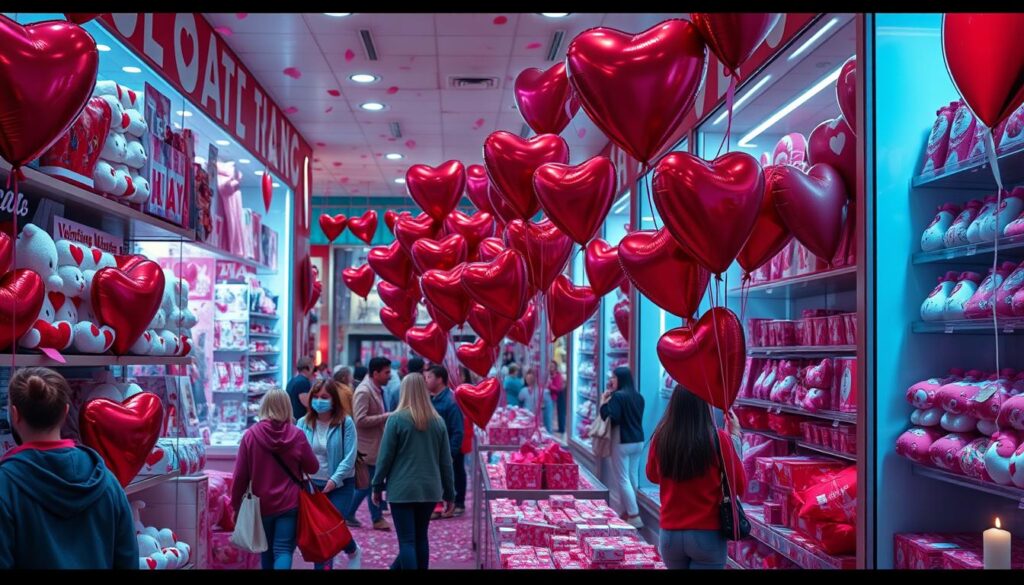
The way we celebrate Valentine’s Day has changed a lot in the United States. It started with ancient traditions but changed a lot in the 20th century. Hallmark played a big role in making it easier to show love through greeting cards.
As Valentine’s Day became more popular, Hallmark started preparing early. They did this to meet the growing demand for cards and gifts. In 2023, the U.S. spent about $21.8 billion on Valentine’s Day, showing its big economic impact.
The move towards making Valentine’s Day more commercial started with Chaucer and Shakespeare. Their work made the holiday more romantic, turning it into a big celebration with gifts and messages.
Today, people enjoy unique Valentine’s Day traditions like sending fancy cards and buying flowers and chocolates. The card industry makes about $1 billion each year because of Valentine’s Day. Around 6 million couples also get engaged on this day, making it special for love.
Hallmark’s impact is seen in card sales and Valentine’s Day movies. These movies focus on love stories, ignoring the holiday’s history. With more people shopping online, buying gifts for Valentine’s Day has gone up by 20% in recent years.
This change shows how Valentine’s Day has become a big part of our culture. It has moved away from its historical roots and changed how we show love.
| Aspect | Statistical Insight |
|---|---|
| Overall Spending | $21.8 billion in 2023 |
| Card Industry Sales | $1 billion annually |
| Engagements | 6 million couples get engaged |
| Average Men’s Spending | $200 |
| Average Women’s Spending | $100 |
| Proportion of Gift Spending | 73% on gifts |
| Online Shopping Growth | 20% increase in purchases |
Modern Celebrations of Valentine’s Day
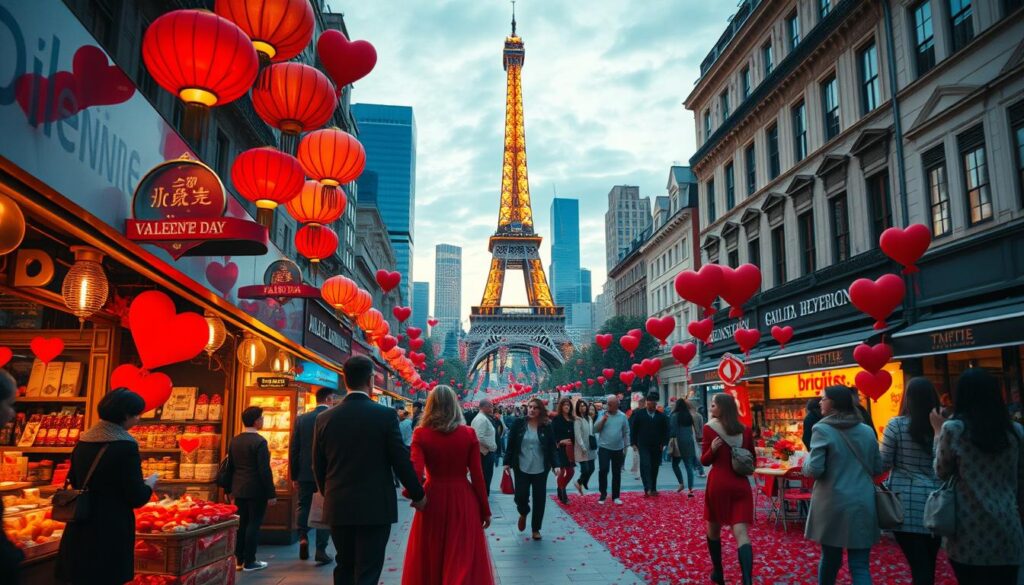
Valentine’s Day has changed a lot over time. It now shows a mix of traditions and customs from all over the world. Each country brings its own special touch to the day, showing love in different ways.
These traditions mix old practices with new trends. They celebrate both love and friendship.
Valentine’s Day Around the World
In Japan, ‘Giri Choco’ is big. Women give chocolates to male friends or coworkers as a sign of respect. In the Philippines, it’s all about big mass weddings. Many couples get married together in a big celebration.
These events show how Valentine’s Day is celebrated differently in each place. They highlight the special Valentine’s Day customs of their cultures.
Gift-Giving Trends and Traditions
Today, gift-giving trends focus on meaningful gifts, not just expensive ones. In the U.S., 62% of people celebrate Valentine’s Day. They spend about $21.8 billion on gifts each year.
Roses are still a big symbol of love. 53% of people give flowers, with roses being the most popular. Many also choose DIY gifts to show their creativity.
| Tradition/Custom | Country | Details |
|---|---|---|
| Giri Choco | Japan | Women give chocolates to male friends or colleagues. |
| Mass Weddings | Philippines | Collective weddings held for budget-conscious couples. |
| Galentine’s Day | United States | Celebration of female friendship, often with brunch or dinner. |
| Lebkuchenherzen | Germany | Gingerbread hearts decorated with romantic messages. |
| Sending Cards | Global | Over 145 million cards exchanged annually in the U.S. alone. |
These changing traditions show how Valentine’s Day can be made personal. It’s about connecting with others, whether it’s romantic or just friendship. The idea of celebrating love brings people together every February 14th.
The Impact of Technology on Valentine’s Day
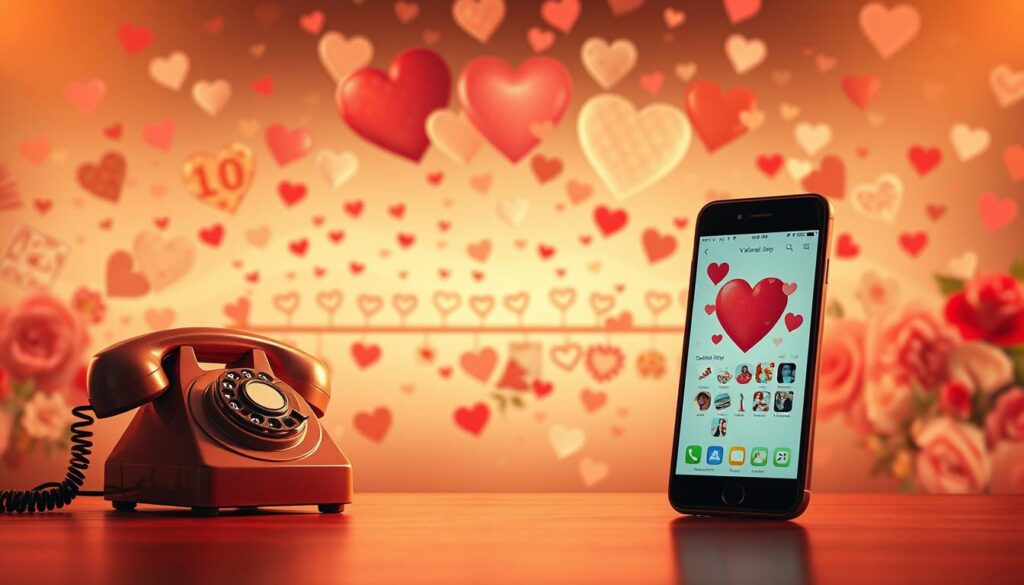
Valentine’s Day has changed a lot thanks to technology. No more just letters and gifts. Now, you can send love online with e-cards and posts. This shows how valentine’s day history has evolved, making communication key in showing love.
Online platforms have changed how we celebrate Valentine’s Day. In 2024, 64% of people plan to buy gifts for their loved ones. About 48% like unique, homemade gifts more than store-bought ones. This shows a desire for something special and personal.
Today, couples enjoy making meals and gifts together. 57% plan to celebrate this way. Crafting DIY gifts has grown by 30% in five years, showing a love for personal touches.
Technology helps long-distance couples stay close with video calls and messages. It’s also changed how we meet partners, with apps like Tinder. The history valentine quotes shared online often show deep connections, not just material gifts.
- 70% of people prefer heartfelt letters or poems over commercial gifts.
- 80% of Millennials value personalized gifts more than material ones.
- 15% of Valentine’s gifts are expected to be handmade items.
- 38% of couples have received a handmade gift in their relationship.
Social media has grown in love and relationships, changing how we see romance. Technology has made Valentine’s Day more about heartfelt expressions than just gifts. This evolution encourages us to celebrate in new, meaningful ways, building deeper connections.
Conclusion
Valentine’s Day is a mix of history and tradition that makes us celebrate love every February 14th. Knowing its history helps us appreciate the many ways to show love. It shows how love has been a part of human life for ages.
In the U.S., over 60% of people celebrate this holiday, making it a big deal. In 2023, Americans spent $21.8 billion on it. This shows how much the holiday means to us today. People now prefer unique gifts and experiences, showing the holiday’s evolution.
Understanding the history of Valentine’s Day helps us celebrate better. We can choose thoughtful gifts, create special moments, or send heartfelt messages. This way, we keep the spirit of love alive, even as the world changes.

